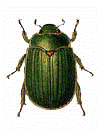Museum, University of Nebraska State
Date of this Version
February 1992
Abstract
The Neotropical genus Hologymnetis (formerly Cineretis) is comprehensively reviewed. Descriptions and a key to the seven species are presented, including three new species (H. kinichahau from Guatemala and Mexico, H. moroni from Mexico, and H. vulcanorum from El Salvador). Hologymnetis margaritis is restored to species status. A cladistic analysis reconstructing the presumed phylogeny of the genus is provided, and a discussion of the characters and their states is given. Hologymnetis cinerea and H. undulata were found to be the most derived species, while H. vulcanorum, H. margaritis and H. kinzchahau are the least derived; H. moroni and H. argenteola are sister species. The biogeographical study indicates that the genus is South American in origin with one species (H. undulata) now occurring there south of the Amazon Basin. Dispersal through Central America after the formation of the Panamanian land bridge is indicated. Descendent taxa then dispersed and speciated from El Salvador through southern and western Mexico and extreme southern Arizona. Subsequent formation of unfavorable habitat (primarily lowland rainforest) from Amazonia to Nicaragua eliminated species of ancestral Hologymnetis previously living there.


Comments
Published in The Coleopterists Bulletin, 46(2): 16 1-202. 1992. Copyright © 1992 by Brett C. Ratcliffe and A. Cuauhtemoc Deloya. Used by permission.